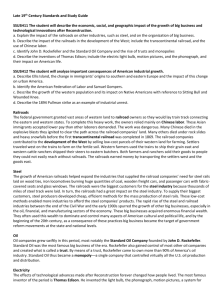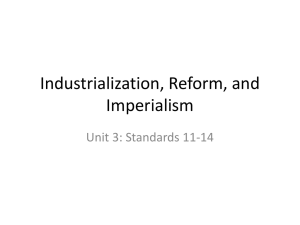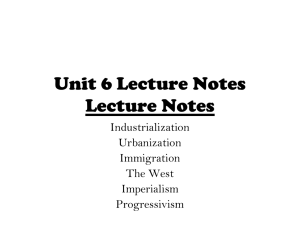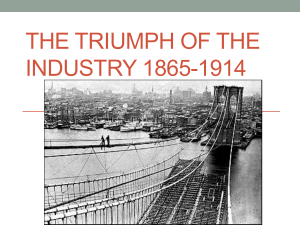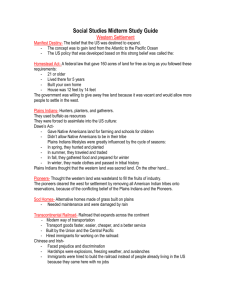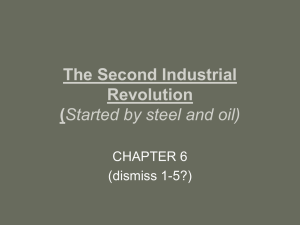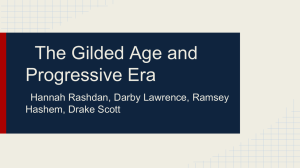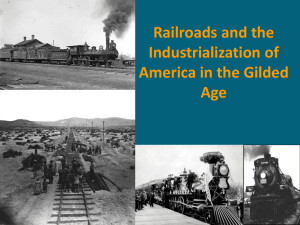Unit 4 (Standards 12-14) - Mr. Carter`s United States History Class
advertisement
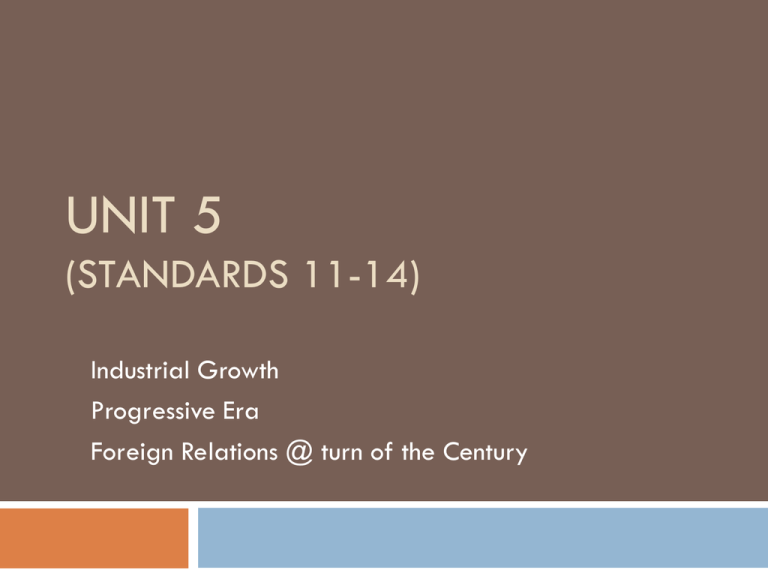
UNIT 5 (STANDARDS 11-14) Industrial Growth Progressive Era Foreign Relations @ turn of the Century SSUSH11 The student will describe the growth of big business & technological innovations after Reconstruction a. Explain the impact of the railroads on other industries, such as steel, and on the organization of big business. The railroad companies contributed to the development of the West by selling low-cost parcels of their western land for farming. Settlers traveled west on the trains to farm on the fertile soil. Western farmers used the trains to ship their grain east, & western cattle ranchers shipped their steers to eastern butchers. Both farmers & ranchers sold their goods to people they could not easily reach without railroads. The railroads earned money by transporting the settlers west & the goods east. a. Explain the impact of the railroads on other industries, such as steel, and on the organization of big business. The growth of American railroads helped expand the industries that supplied the railroad companies’ need for steel rails laid on wood ties, iron locomotives burning huge quantities of coal, wooden freight cars, & passenger cars with fabric-covered seats & glass windows. The railroads were the biggest customers for the steel industry because thousands of miles of steel track were laid. In turn, the railroads had a great impact on the steel industry. To supply their biggest customers, steel producers developed cheap, efficient methods for the mass production of steel rails. These low-cost methods enabled more industries to afford the steel companies’ products. a. Explain the impact of the railroads on other industries, such as steel, and on the organization of big business. The rapid rise of the steel & railroad industries between the end of the Civil War & the early 1900s spurred the growth of other big businesses, especially in the oil, financial, & manufacturing sectors of the economy. These big businesses acquired enormous financial wealth. They often used this wealth to dominate & control many aspects of American cultural & political life, & as a consequence of these practices, by the beginning of the 20th century big business became the target of government reform movements at the state & national levels. b. Describe the impact of the railroads in the development of the West; include the transcontinental railroad and the use of Chinese labor. The federal government granted vast areas of western land to railroad owners so they would lay train track connecting the eastern & western states. To complete this heavy work, the owners relied mainly on Chinese labor. These Asian immigrants accepted lower pay than other laborers demanded. The work was dangerous. Many Chinese died in the explosive blasts they ignited to clear the path across the railroad companies’ land. Many others died under rock slides & heavy snowfalls before the first transcontinental railroad was completed in 1869. c. Identify John D. Rockefeller and the Standard Oil Company and the rise of trusts and monopolies Oil companies grew swiftly in this period, most notably the Standard Oil Company, founded by John D. Rockefeller. Standard Oil was the most famous big business of the era. Rockefeller also gained control of most other oil companies & created what is called a trust. By means of a trust, Rockefeller came to own more than 90% of America’s oil industry. Standard Oil thus became a monopoly––a single company that controlled virtually all the U.S. oil production & distribution. d. Describe the inventions of Thomas Edison; include the electric light bulb, motion pictures, and the phonograph, and their impact on American life. The effects of technological advances made after Reconstruction forever changed how people lived. The most famous inventor of the period is Thomas Edison. He invented the electric lightbulb, the phonograph, motion pictures, a system for distributing electrical power, & many other technologies powered by electricity. Edison also established the concept of industrial research, & he founded a research laboratory staffed by engineers & technicians in New Jersey. d. Describe the inventions of Thomas Edison; include the electric light bulb, motion pictures, and the phonograph, and their impact on American life. Edison’s technological achievements were used by other inventors, as evidenced by the development of long-distance electricity transmission, which enabled Edison’s electric light to illuminate buildings, streets, & neighborhoods across the United States. Electricity soon replaced steam as the source of power for factories. It replaced horses as the means to power streetcars. Of greatest impact, perhaps, was electricity’s replacing humans as the source of power for household appliances. Edison’s inventions eliminated much manual labor that had been associated with everyday household activities & improved Americans’ quality of life. SSUSH12 – The student will analyze important consequences of American industrial growth. a. Describe Ellis Island, the change in immigrants’ origins to southern and eastern Europe and the impact of this change on urban America. New Immigrants – from Southern & Eastern Europe Came mostly for political & economic reasongs Entered through Ellis Island Ellis Island – place of inspection & processing of immigrants in NYC These immigrants settled mostly in cities in the NE Not welcomed, low paying jobs Impact on urban areas (problems) Housing, transportation, water, sanitation, fire, crime Ellis Island Registry Room Registry Room Today Ellis Island Immigrants b. Identify the American Federation of Labor and Samuel Gompers. American Federation of Labor (AFL) - 1886 Skilled workers only, smaller membership Used collective bargaining and strikes Some success with higher wages and shorter work weeks Still exists today as AFL-CIO Founded by Samuel Gompers c. Describe the growth of the western population and its impact on Native Americans with reference to Sitting Bull and Wounded Knee RR make it easier for people to move west (transcontinental Railroad - 1869) Gov’t gives money and land grants to RRs Lifestyle of the Plains Indians is threatened: Nomadic – move from place to place Buffalo is important to life Settlers destroy buffalo population From 15 million in 1865 to 600 in 1886 Joining of the Transcontinental RR (May 10, 1869) Natives Relationship with the U.S. Conflict is over LAND: Indians need for hunting and settlers want it for farming and mining US agreed to give the SIOUX nation a large reservation of land in the Dakotas US breaks treaty and moves in when GOLD is found in the Black Hills Sitting Bull was a Sioux leader who helped defeat U.S. forces at Little Big Horn Battle of Wounded Knee (1890)- US soldiers capture and kill more than 300 unarmed Native including children. Ended Indian resistance. Chief Big Foot’s Body Wounded Knee, SD, 1890 d. Describe the 1894 Pullman strike as an example of industrial unrest. Pullman was a railroad car company. Workers lived in Pullman owned homes Pullman Company laid off 3,000 of 5,800 workers Cut wages 25-50 percent, didn’t cut the rents in the company town American Railway Union (led by Debs) began strike, which turned violent Strikebreakers were hired Pres. Cleveland sent in federal troops to end the strike SSUSH13 – The student will identify major efforts to reform American society & politics in the Progressive Era. a. Explain Upton Sinclair’s The Jungle and federal oversight of the meatpacking industry. Upton Sinclair: Muckraker who wrote “The Jungle” that exposed horrible conditions in the meat packing industry Led to the Meat Inspection Act & Pure Food and Drug Act d. Explain Ida Tarbell’s role as a muckraker. Muckrakers: writers and journalists who exposed all the evils of society Ida Tarbell: exposed corruption in the Standard Oil Company 1911: Standard Oil broken up by the courts b. Identify Jane Addams and Hull House and describe the role of women in reform movements. Settlement Houses: helped immigrants adjust to life in the American cities. Kind of like a community center. Jane Addams— founded the Hull House Women’s right to VOTE (suffrage) 19th Amendment U.S. Response to their help in supporting World War I c. Describe the rise of Jim Crow, Plessy v. Ferguson, and the emergence of the NAACP. “Jim Crow” laws legal segregation (separation) of the races lasts until the 1960s Plessy v. Ferguson (1896) Supreme Court case that established policy of “separate but equal”, which meant segregation was legal. Separate facilities for blacks and whites are okay as long as there are facilities for both. NAACP: National Association for the Advancement of Colored People Founded in 1909 to fight for social, political, and economic equality e. Describe the significance of progressive reforms such as the initiative, recall, and referendum; direct election of senators; reform of labor laws; and efforts to improve living conditions for the poor in cities. Increasing Democracy Initiative - People have the right to propose laws Referendum - People vote & have final approval on a law Recall – People can remove an official from office before their term is over 17th Amendment – Direct election of Senators (by the people) Labor laws Child labor, working conditions, compensation laws Conditions for the Poor Jacob Riis – wrote “How the Other Half Lives” – photojournalism about urban poverty Tenement Slum Living Child Labor TRIANGLE SHIRTWAIST FACTORY FIRE NYC 1911 Typical NYC Sweatshop, 1910 Inside the Building After the Fire Dead Bodies on the Sidewalk Scene at the Morgue (145 Dead) f. Describe the conservation movement and the development of national parks and forests; include the role of Theodore Roosevelt. President Theodore Roosevelt also began a Progressive conservation movement, which conserved millions of acres of wilderness lands, particularly in western states. His efforts led to the establishment of a national park system that included Yosemite in California & Yellowstone in Wyoming. SSUSH14 – The student will explain America’s evolving relationship with the world at the turn of the twentieth century. a. Explain the Chinese Exclusion Act of 1882 and antiAsian immigration sentiment on the west coast. Chinese immigrants were coming to the U.S. on the west coast (Angel Island). Worked on railroads and took lower wages for jobs. This created an anti-Asian sentiment among native-born Americans who feared that jobs would go to Chinese immigrants. In 1882, Congress passed the Chinese Exclusion Act, which banned all future immigration from China except students, teachers, tourists, merchants, & gov’t officials. Was not repealed until 1943. b. Describe the Spanish-American War, the war in the Philippines, and the debate over American expansionism. Spanish-American War (1898) In 1895 Jose’ Marti (Cuba) started another revolution against Spain. Spain responded by sending in Valeriano Weyler, who put nearly 300,000 Cubans in concentration camps. U.S. helps Cuba – Causes of War Yellow Journalism - exaggerating or stretching the truth DeLome Letter – Private letter from Spanish minister to the U.S. which insulted Pres. McKinley. Sinking of the USS Maine – U.S. battleship explodes while sitting in the harbor of Habana, Cuba. U.S. blames Spain. April 1898 U.S. declares war on Spain b. Describe the Spanish-American War, the war in the Philippines, and the debate over American expansionism. Treaty of Paris (1898) – Ended war with following terms: Cuba is independent U.S. gets Puerto Rico, Guam, and the Philippines U.S. pays Spain $20 million As a result of the Sp-Am War: U.S. now owns an empire Ends U.S. isolationism U.S. emerges as a world power Philippine-American War After Sp-Am War, Filipinos were angry that the U.S. simply replaced the Spanish as a controlling power Emilio Aguinaldo led a revolt against U.S. forces in 1899. b. Describe the Spanish-American War, the war in the Philippines, and the debate over American expansionism. War lasted 3 years, killing nearly 25,000 people. U.S. gave Philippines partial home rule 1946 given complete independence American Expansionism Many were concerned about America’s expansionism and continued involvement in Latin America. c. Explain U.S. involvement in Latin America, as reflected by the Roosevelt Corollary to the Monroe Doctrine and the creation of the Panama Canal Panama Canal - A canal built by the U.S. cutting across Central America to reduce travel time and provide a short cut between the oceans for commercial and military ships. U.S. chose Panama for the canal, which belonged to Colombia. They refused our offer…wanted more $. US helps Panama rebel against Colombia Panama accepts our offer ($10m and $250,000 a year) Canal built between 1904-1914 c. Explain U.S. involvement in Latin America, as reflected by the Roosevelt Corollary to the Monroe Doctrine and the creation of the Panama Canal Roosevelt Corollary European powers were getting involved in Latin America TR wanted US to be the most powerful influence in Latin Am. Based on the African proverb “Speak softly and carry a big stick” The Roosevelt Corollary stated: the U.S. would use force to protect its economic interests in Latin America
